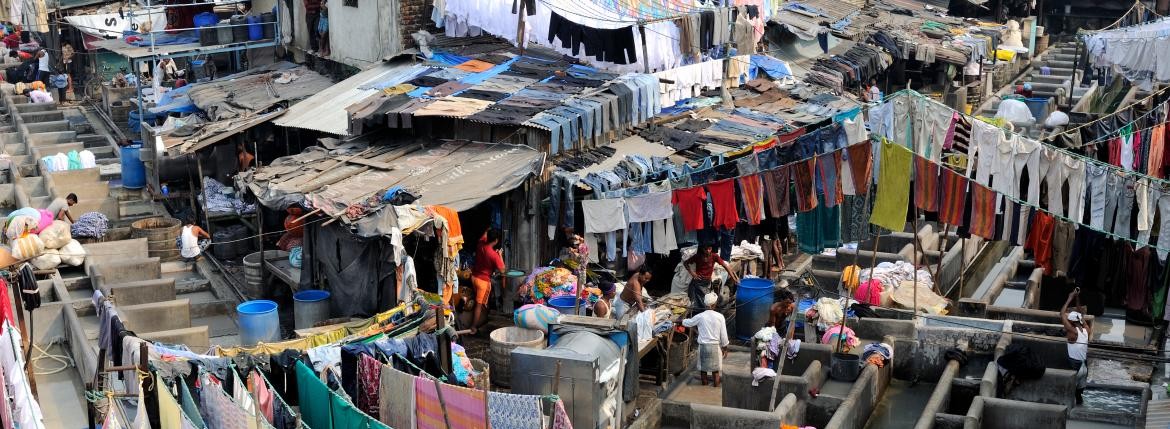
There’s this spot in Mumbai, often seen on photographs, magazines and movies. Chances are you’ve seen a few actors run through the open cement washing tanks and clotheslines tied through alleys with linen up for drying. A couple of launderers washing clothes right under the sun.
That place is called the Mahalaxmi Dhobi Ghat, or just the Dhobi Ghat. It’s an open-air laundromat – something alien to most people today. Etymologically, the word ‘Dhobi’ meaning washer or launderer and ‘Ghat’ meaning a bank of a river or water body’s shore. This name has existed almost as long as the place itself has.
Constructed in all the way back in the 19th century when we were still under British rule, in 1890. This lavoir has served as the most prominent in most cases the only workplace for these washers. They gather the linen from hospitals, hotels, and such- which are then washed under the open air here.
The utility and success in the workflow of the dhobi ghat in Mumbai (then Bombay) was immense. Inspired by and motivated to make another functional dhobi ghat in India, the British got to work. Finally, in 1902 a second Dhobi Ghat was opened and started operating in Kolkata (then Calcutta).
It is situated near Mahalaxmi railway station on the Western Railway’s Saat Rasta roundabout. Visible in the clean view from the flyover bridge of Mahalaxmi station- it has become a landmark over the years. Being one of the largest Laundromats and the largest open-air Laundromats in the world- it is a tourist hotspot.
Some Lesser known facts about Dhobi Ghat
It has managed to stay functional without shutting down for over one and a quarter-century. Slowly but steadily cementing its position as firm as its own washing pens as the main source of income for a large population. There is a lot of people that have lived, made a living for themselves, and thrived here.
There is a unified central organization that represents dhobis or washers in order to ensure their minimum wages/rates. This organization also makes sure they’re following a code of operation, unified against prejudice and protected against unlawful prosecution. The Dhobi Kalyan & Audhyogik Vikas Cooperative Society.
The evaluation of this humble enterprise is more than surprising- it is unassumingly high. The turnover for Dhobi ghat is well over a hundred crore rupees a year. It was given the honorable accolade of a Guinness Book of World Record’s record for most people simultaneously washing in one location at a time, in 2011.
Just like a perfectly oiled machine with intricate design- work never stops at the Dhobi Ghat. Every day about three-quarters of a day and even more, about 7,000 people flog, scrub, dye, and bleach clothes. They hang them on clotheslines and neatly iron them (at one point in time it was done with coal-based irons, sometimes even today too).
Transporting the garments to different parts of the city is another aspect of the job that the dhobis undertake and deliveries are made in time. There’s little margin for error and when dealing with a city like Mumbai it’s thinner still. This place singlehandedly makes sure most of the linen in the economic center of India is washed.
With that said, the numbers are anxiety-inducing and we’re not even the dhobi’s that have to do the job. Over a hundred thousand individual pieces of clothing come into the Dhobi Ghat for cleaning every day. In order to compete with the increasing demand and to keep up with the ever-expanding Mumbai- mechanical solutions are employed now and washing from hand has been abandoned by the dhobis.
With forever active machine wash and dryers, the ghat is more than enough equipped to hold outsourcing jobs as well. The neighboring Laundromats that are significantly lacking in resources outsource their washing and drying to the Ghat. Most of the hotels, PGs, hospitals, nursing homes and such also source their cleaning jobs to the ghat.
It is a remarkable historical and cultural insignia for Mumbai. A good example of how demand gets served with people coming together to fulfill the supply and in the process some lives are saved- poverty avoided, plates not left empty and children stick to schools.
